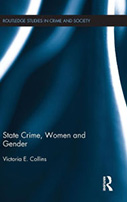State Crime, Women and Gender

Author: Victoria E. Collins
Publisher: London; New York: Routledge, 2016. 238p.
Reviewer: Kimberly M. Pitts | September 2016
In State Crime, Women and Gender, one of the eighteen books of the Routledge studies in crime and society series, criminologist Victoria E. Collins addresses the gap in the literature between gender studies and state crime. Using domestic and international case studies framed in a multi-level analytical model, she explores gendered state crime. While many studies portray women as victims of state crime, Collins recognizes women’s involvement as contributors to state-perpetuated violence against women through consumer choices and employment decisions.
Collins dedicates the first three of eleven chapters to defining major concepts and key issues, and establishing a theoretical framework for her analysis of state crime and women. Starting with a basic discussion of the difference between sex and gender, she conceptually links the institutionalization of sex role socialization to gendered violence. Stating that gender differences were not recognized in the field of criminology until the 1970s — and then women were viewed as victims or employees — she establishes the need for her study and reminds readers that women as victims or perpetrators of state crime has only recently been addressed in the literature.
As this field of study in criminology is relatively new, attention is given to the definitions of gendered violence and state crime. The lack of laws until the 1980s regarding intimate partner violence in the United States is proof of how gender-based violence can be state- sanctioned. State-perpetrated violence against women however, has been common throughout history as women have been systematically physically and sexually abused and subordinated to men. From the Vikings practice of raping the women of their enemies, to United States pharmaceutical corporations controlling women’s reproduction and subjecting their bodies to harm in exchange for foreign aid, women have been victimized by state entities. While the philosopher Augustine and sociologist Max Weber, as well as other theorists, have for centuries discussed the concept of state crime, it was not until 1989 when William Chambliss addressed the American Society of Criminology that the field of criminology incorporated a study of state crime.
Collins adopts a definition of direct or indirect state violence as being that which violates human rights. The legality of forced marriage of underage girls in Lebanon and Yemen, contrary to the United Nations convention against such marriage, is an example of a direct form of state-sanctioned gendered violence. The states’ complicity in some forms of violence against women, such as sexual harassment in the military, is more covert and subtle. The indirect form of state sanctioned gendered violence refers to structural inequalities and an absence of laws and policies, or a culture that actively protects women.
Having established the field of study, her focus turns to the theoretical framework. An integrated theoretical model of state crime which considers crime at the micro, meso, macro and international levels through four dimensions- motivation, opportunity, constraints, and controls in inadequate for a gendered study of state crime, as it does not address gender. Recognizing the importance of a gendered theoretical model, Collins discusses and moves beyond the five main feminist perspectives (Liberal, Marxist, Radical, Socialist and Black feminist Intersectionalist) to include African, postmodern and international relations perspectives on gendered state crime. She provides an alternative that incorporates gender into an integrated theoretical model of state crime.
When one thinks of state-perpetuated violence against women, it is usually framed in a conflict or war scenario. While women do experience a direct form of violence during such times, victimization remains in an indirect fashion during times of peace as well.
Women’s bodies have been uniquely targeted during times of conflict and war in the sense of gendered violence being used as a patriarchal strategy. Collins incorporates global case studies to demonstrate direct state-sanctioned gendered violence. During times of war throughout history, women have been used as pawns and their bodies have been subjected to rape and torture — with those acts justified by the phrase “spoils of war”. Japan’s ‘comfort women’ demonstrate the commodification of women’s bodies during wartime. Contemporary examples of sexual violence against women during the conflicts in the former Yugoslavia and Rwanda demonstrate the continued targeting of women to send messages of fear to the entire community. Genocidal rape, a strategy of ethnic cleansing in the former Yugoslavia, and forced impregnations in Bosnia represent state violence that aimed to use women’s bodies to alter an entire culture’s composition. In Sierra Leone, young girls were forced to become child soldiers engaging in gender specific domestic and sexual tasks as well as combat roles.
Not only are women uniquely targeted for sexual violence during times of war, they are also more likely than men to be civilian casualties and displaced in refugee camps where they are especially vulnerable to sexual assault. The Haitian governments’ complicity in failing to protect female refugees from sexual assault by armed gangs is well-documented. Furthermore, in some traditional patriarchal societies, such as Iraq, even women who are enslaved and sex trafficked may be prosecuted by the state for prostitution.
During times of peace, indirect violence against women is so deeply engrained in social institutions that it appears normal. The gender wage gap and discriminatory employment practices, while not inherently violent, contribute to women’s vulnerabilities. Sexual harassment in the workplace and on college campuses in the United States is increasing to the extent that businesses and universities which ignore such violations may be found complicit. On a global level, laws allowing forced child marriages in some African and Asian countries subject young girls to a quotidian violence. Saudi Arabia is an example of a more overt indirect gendered violence. The girl of Qatif, who reported her rape to the authorities, was herself arrested for violating Sharia law by being in a car alone with a man. Not only was her sexual assault not acknowledged, she continued to be victimized by the police. Impunity in countries such as India has led to a rape culture aimed at controlling women’s behavior. States continue to be complicit in violating women’s rights despite United Nations conventions regarding human rights.
While men are overwhelmingly the aggressors of state violence, some women have also taken the role of perpetrator. Former National Security Advisor to George W. Bush, Condoleezza Rice, could be said to represent a high-level offender in her support of invading Iraq and of torturing Guantánamo Bay prisoners using water boarding. Her role has however been explained as being a normal part of the job. Lynndie England, the army soldier who was photographed abusing an Iraqi detainee, is illustrative of a lower-level offender who was held accountable for her role in perpetuating state violence. Women who do not conform to traditional gender ideologies, such as England, are more likely to be punished. Some women, such as Liberian rebel Black Diamond, opt to join military groups after suffering sexual violation, as a strategy to prevent further victimization. However, in order to prevent continuing sexual victimization, they must “gender bend” by demonstrating traditional male qualities of aggression and violence.
While not widely studied, women have indeed participated in gendered violence both directly and indirectly. Female genital mutilation is a form of honor based violence perpetrated by women. Female politicians in the United States have contributed to the continuing subjugation of women by voting against reproductive rights and legislation regarding gender wage equality. Furthermore, laws intended to protect women, such as the Violence Against Women Act and domestic violence laws, may further victimize women through incarceration and the loss of children to social services. Women’s perpetuation of indirect gendered state violence occurs through the consumption of media that denigrates women, and their activism in anti-feminism campaigns only serves to reinforce patriarchy.
Women who resist any form of state violence likely do so at significant risk to themselves and their families, as the very act of resistance is contrary to gender norms. Furthermore, when women resist against the state, which is considered the “protector” of women, the state may leave them vulnerable to violence from other agencies. Despite the dangers, individuals and groups of women stand up to injustices, engaging in clandestinely writing resistance poetry in Afghanistan to actively protesting in the streets of Liberia and Egypt. The state response to women’s resistance has often been an overt countermovement in which the media have been used to propagate campaigns against women resistors. In the United States, the counter campaign against feminism perpetuated such concepts as ‘husband abuser’ and ‘welfare queens’. The media have also been used as a tool against individual agents of change, such as when Egyptian women were labeled sexual deviant for their political involvement.
Formal justice at the international level is available to select women through United Nations International Criminal Courts and Tribunals. Through the International Criminal Tribunal, cases of wartime rape in the former Yugoslavia were prosecuted under a torture convention, and the prosecution of rape during the conflict in Rwanda fell under an international genocide law. However, few cases of sexual violence are argued in the international courts due to numerous barriers, including knowledge of the application process, access to legal counsel, and the burden of proof. For most women, wartime victimization continued even after the conflict, as they were shunned by their families because they were no longer considered pure, or they carried babies of the enemy. After the genocide in Rwanda, many women widowed during the conflict were left homeless since they were not allowed to take ownership of their own homes. As gendered violence is often defined only as sexual violence, loss of economic resources is not considered a part of gendered state victimization.
While several mechanisms of domestic justice exist, domestic judicial systems have been the least effective at prosecuting gendered violence, as the state is the perpetrator of state crimes through omission, impunity, and direct action. Special courts of hybrid tribunals made up of state and international actors were used in Sierra Leone to prosecute Charles Taylor and members of his front. Truth and Reconciliation Commissions document human rights violations and provide a platform for victims to share their experiences; however, gender-based violence is often under-reported. Women have been more outspoken about their victimization experiences through their participation in People’s Tribunals.
United Nations Women was organized to incorporate women’s voice in international affairs. The International Criminal Court proposes to be more gender balanced, yet at the International Criminal Tribunal level and hybrid state systems, women are underrepresented. Truth and Reconciliation Commissions, which have no legal authority, have more female representation. Collins notes, however, that equal representation is insufficient and commissioners should have specialized training in issues related to gendered violence. Despite shortcomings, women have taking greater leadership roles. Afghan women have been active at the state level in rebuilding the government and working towards gender equality. At the grassroots global level, the Pink Saris, a women’s movement in India, publically speaks out against gendered violence.
State Crime, Women and Gender, takes a micro-, meso-, macro-level and international approach in examining state-perpetrated crime against women. The integration of global case studies frames the argument. The book is well-researched and referenced. That said, the lack of reference to state crime and women’s resistance in Latin America is quite surprising. The book is likely to appeal to students and academics in the social sciences. Anyone working in the criminal justice system at the state or international level would learn valuable lessons in reading this book. Victoria Collins has given us an important work that unites state crime and gender.
Kimberly Mathis Pitts, Ph.D., Assistant Professor of Sociology, Campbellsville University


